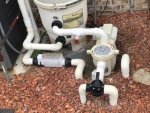Hello,
I purchased a new Pentair Intellflo VS pump and installed it a couple days ago. My neighbor is a licensed electrician so the electrical is complete and working great. My questions are all related to my current plumbing layout and determining if improvements are recommended. Outside of the heater and salt generator my layout seems pretty straight forward. I've noticed a small leak from the pump to the filter so I need to redo it so I figured if other changes will improve performance then I may look at my options before replacing according to the current setup. I'm looking for all improvements regardless of severity and location so please fire away. I also have about 2 feet of clearance to the right of my pump before my air conditioner so moving the pump location is also an option.
Thanks!

I purchased a new Pentair Intellflo VS pump and installed it a couple days ago. My neighbor is a licensed electrician so the electrical is complete and working great. My questions are all related to my current plumbing layout and determining if improvements are recommended. Outside of the heater and salt generator my layout seems pretty straight forward. I've noticed a small leak from the pump to the filter so I need to redo it so I figured if other changes will improve performance then I may look at my options before replacing according to the current setup. I'm looking for all improvements regardless of severity and location so please fire away. I also have about 2 feet of clearance to the right of my pump before my air conditioner so moving the pump location is also an option.
Thanks!


